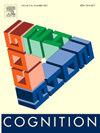Beyond numerical quantity: A study of the sub-base-five effect in single-digit comparison
IF 2.8
1区 心理学
Q1 PSYCHOLOGY, EXPERIMENTAL
引用次数: 0
Abstract
Previous findings suggest that the mental representations involved in symbolic number comparison carry information not only about the numerical quantity they denote, but also about higher-order properties. While the time to compare pairs of digits increases continuously with numerical size, former studies also revealed a categorical effect characterised by a step increase in response times for pairs with at least one digit >5 compared to those including only digits ≤5. In line with the embodied cognition view, this step increase was interpreted as an inheritance from finger counting practices. This “sub-base-five” effect would find its origin in the need to generate the mental representation of two hands to process numbers >5, whereas one hand is sufficient to represent numbers ≤5. We provide evidence against this interpretation using new analyses designed to uncouple the continuous effect of numerical size and the categorical sub-base-five effect. We demonstrate that the time to compare two Arabic numerals is primarily determined by numerical size, with no steeper increase between pairs with or without number >5. We explain that the sub-base-five effect in digit comparison was likely an artefact of the modelling method previously used to control for numerical size. We nevertheless identified a robust response time increase when comparing 5 and 7, which could not be accounted for by numerical size. These findings question the existence of a sub-base-five effect, which was considered as a marker of embodied cognition, but prompt interest for a previously unnoticed effect emphasizing the special status of particular prime numbers 5 and 7 in symbolic number comparison.
超越数字数量:个位数比较中次五进制效应的研究
先前的研究结果表明,涉及符号数比较的心理表征不仅包含它们所表示的数字数量的信息,还包含高阶性质的信息。虽然比较数字对的时间随着数字的大小而不断增加,但以前的研究也揭示了一种分类效应,其特征是与只包含≤5的数字相比,至少包含一个数字>;5的数字对的响应时间会逐步增加。与具身认知观点一致,这一步骤的增加被解释为手指计数实践的继承。这种“次五进制”效应的根源在于,处理数字需要两只手的心理表征,而一只手就足以表示≤5的数字。我们提供证据反对这种解释使用新的分析,旨在解耦数值大小的连续效应和分类次基数五效应。我们证明,比较两个阿拉伯数字的时间主要由数字大小决定,在有或没有数字>;5的对之间没有陡峭的增加。我们解释说,在数字比较中的次基数五效应可能是以前用于控制数字大小的建模方法的人工制品。然而,在比较5和7时,我们发现了一个健壮的响应时间增加,这不能用数值大小来解释。这些发现质疑了次五进制效应的存在,该效应被认为是具身认知的标志,但引起了人们对先前未被注意的效应的兴趣,该效应强调了特定素数5和7在象征性数字比较中的特殊地位。
本文章由计算机程序翻译,如有差异,请以英文原文为准。
求助全文
约1分钟内获得全文
求助全文
来源期刊

Cognition
PSYCHOLOGY, EXPERIMENTAL-
CiteScore
6.40
自引率
5.90%
发文量
283
期刊介绍:
Cognition is an international journal that publishes theoretical and experimental papers on the study of the mind. It covers a wide variety of subjects concerning all the different aspects of cognition, ranging from biological and experimental studies to formal analysis. Contributions from the fields of psychology, neuroscience, linguistics, computer science, mathematics, ethology and philosophy are welcome in this journal provided that they have some bearing on the functioning of the mind. In addition, the journal serves as a forum for discussion of social and political aspects of cognitive science.
 求助内容:
求助内容: 应助结果提醒方式:
应助结果提醒方式:


